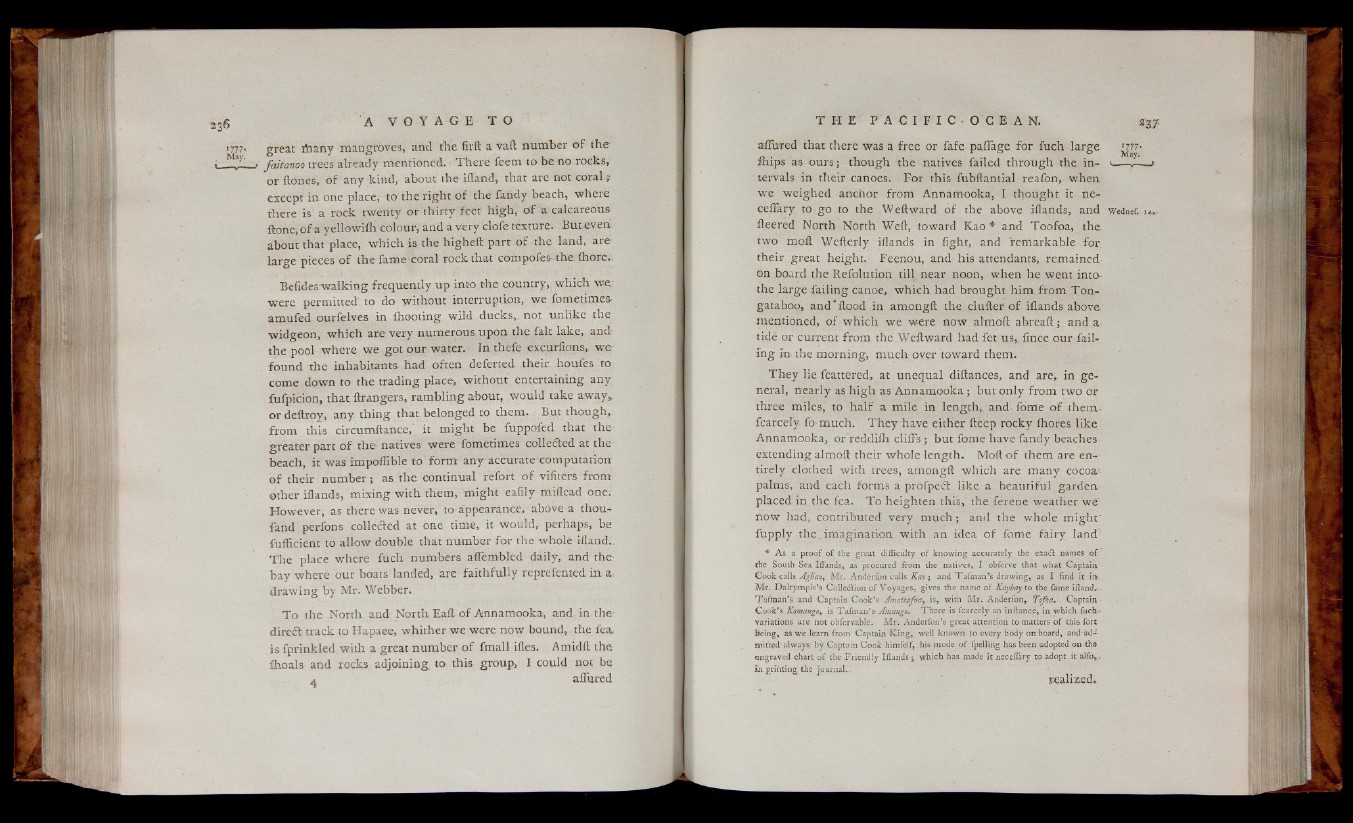
1777. g reat riaa.ny mangroves, and the firft a vaft number of the*
i M_a_ . faitanoo trees already mentioned. There feem to be no rocks,
or ftones, of any kind, about the ifland, that are not coral;
except in one place, to the right of the fandy beach, where
there is a rock twenty or thirty feet high, of a calcareous-
ilone, of a yellowifh colour, and a very clofe texture. But even,
about that place, which is the higheft part of the land, are
large pieces of the fame coral rock that comgofes the ihore..
Beiides walking frequently up into the country, which we,'
were permitted, to do "jvithout interruption, we fometimes-
amufed ourfelves in fliooting wild ducks,, not unlike the
mffljUfluil-i'*' widgeon, which are very numerous upon the fait lake, andthe
pool where we got our water. In thefe excurfions, we
found the inhabitants had often deferred their houfes to
come down to the trading place, without entertaining any,
fufpicion, that ftrangers, rambling about, would take away,,
or defttoy, any thing that belonged to them. But though*
from this circumftance, it might be fuppofed that the
greater part of the natives were fometimes collected at the-
beach, it was impoffible to form any accurate computatiorr
of their number; as the continual refort of vifiters from:
other iflands, mixing with them, might eaiily miflead one:
However, as there was never, to-appearance, above a thou-
land perfons collected at one time, it would, perhaps, be
fufficient to allow double that number for the whole iflandi.
The place where fuch numbers aflembled daily, and the
bay where our boats landed, are faithfully reprefented in a.
drawing by Mr. Webber.
To the North and North Eaft of Annamooka, and in the-
diredt track to Hapaee, whither we were now bound, the fete
is fprinkled with a great number of fmall iiles. Amidft the
fhoals and rocks adjoining, to this group, I could not be
^ aiTuned
aflured that there was a free or fafe paflage for fuch large
fhips as ours; though the natives failed through the intervals
in their canoes. For this fubilantial reafon, when
we weighed anchor from Annamooka, I thought it ne-
ceffary to go to the Weft ward of the above iflands, and
fleered North North Weft, toward Kao * and Toofoa, the.
two moft Wefterly iflands in fight, and "remarkable for
their great height. Feenou, and his attendants, remained
on board the Refolution till near noon, when he went into
the large failing canoe, which had brought him from Ton-
gataboo, and‘ flood in amongft the clufter of iflands above
mentioned, of which we were now almoft abreaft; and a
tide or current from the Weft ward had fet us,, fince our failing
in-the morning, much over toward them.
They lie fcattered, at unequal diftances, and are, in general,
nearly as high as Annamooka ; but only from two or
three miles, to half a mile in length, and fome of them
fcarcely fi> much. They have either fteep rocky ihores like
Annamooka, or reddiih cliffs ; but fome have fandy beaches
extending almoft their whole length. Moft o f them are entirely
clothed with trees, amongft which are many cocoas
palms, and each forms a profpedt like a beautiful garden
placed in the fea. To heighten this, the ferene weather we
now had, contributed' very mu c h a n d the whole might
fupply the imagination with an idea of fome fairy land"1
* As a proof of the great difficulty- of knowing accurately the . exa& names of.
the South Sea Iflands, as procured from the. natives, I obferve that, what Captain
Cook calls AgJiaoy Mr.. A rider ion calls Kao j and Tafman’S drawing, as I find it ii*
Mr. Dalrymple’s Colle&ion of Voyages, gives the name of Kaybay to the fame ifland*-
Tafman’s and Captain Cook’s AmaUafoa, is, with Mr. Anderfon,' Tofoa. Captain
Cook’s Komango, is Taim an’S' Amango. There is fcarcely an inftance, in which fuch-
variations are not obfervable. Mr. Anderfon’s great attention to matters of this iort.
being, as we learn from Captain King, well known to every body on board, and ad-I
mit'ted always- b y ,Captain Cook himfelf, his mode of-fpelling has been «adopted on the
engraved chart of the Friendly Iflands which has made it-neceflary to adopt.it alfo*.
ih printing the journal..
realized.
1777.
May.
Wednef. 14><